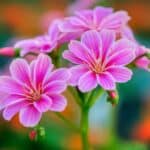Have you ever seen a bright yellow flower with a black center, and wondered what it meant? If so, then you’ve probably encountered one of the most beloved wildflowers in America—the Black-Eyed Susan.
This cheerful bloom has been around for centuries, with meanings that range from good luck to “you are my only love.”
Let’s explore what this stunning flower could mean when given as a gift or decoration.
What Are Black-Eyed Susans?
Have you ever seen a flower with an eye-catching yellow center? Chances are, you’ve stumbled upon a Black-Eyed Susan. But what exactly is this flower, and where did it come from?
Plant Name and Origin
Black Eyed Susan flowers, also known as Sweet William, get their name from the common phrase “turning up like a black-eyed Susan”.
This phrase was first used by English poet John Gay in 1729 to describe someone who suddenly appears without warning. The plant itself originated in North America, but has since spread throughout many parts of the world.
The scientific name for the flower is Rudbeckia hirta, and it belongs to a genus of over 20 other species of flowering plants.
More About Black Eyed Susans
Black Eyed Susans are some of the most beautiful and breathtaking flowers to behold, growing to about two feet tall in full sun with a dark center and double gold petals.
Also known as America’s favorite wildflowers, these beautiful blooms can attract butterflies and all other kinds of pollinators.
While they are most often grown outside among other black eyed susan companions and wildflowers like Russian sage, goldenrod, and other pioneer plants, Black Eyed Susans can even be grown indoors.
These self seeding flowers thrive in sandy soil but can also be grown in a sunny window. They look beautiful in floral arrangements and even gift baskets.

What is Unique About Black-Eyed Susan?
The black-eyed Susan flower, or Rudbeckia hirta, has a long history of growth in the wild. Native to the east coast of the United States and southern Europe, black-eyed Susan was used by ancient cultures for beauty, edible nutrition and medicinal value.
This naturally occurring flower consists of conspicuous yellow petals with dark brown centers that spread open wide during early autumn.
A member of the daisy family, black-eyed Susan readily grows in clusters throughout temperate climates. Surely enough, black-eyed Susan is unique for its abundant history and natural capacity for growth across regions.
The Black-Eyed Susan has been used as a symbol throughout history and across cultures. In some Native American tribes, it has been used to represent peace and unity between different peoples.
In other cultures, it is seen as a symbol of hope and renewal after difficult times. In Victorian England, it was seen as a sign of beauty and innocence.
In addition to its symbolic meaning, the Rudbeckia flowers also have some practical uses. It can be dried and used as an herbal remedy to treat headaches or skin inflammation due to its anti-inflammatory properties. It is also sometimes used in crafts or decorating projects due to its bright yellow color and distinct shape.
What is the Cultural Significance of a Black Eyed Susan Flower?
To understand the true Black Eyed Susan symbolism, it’s important to understand the traditions behind the many Black Eyed Susan varieties throughout history.
The Black Eyed Susan flower is a beautiful and vibrant yellow flower that is native to North America. It has a long history of symbolism associated with it, including the sporting world, politics, and even music. Let’s take a look at what makes this flower so special.
What Did Native Americans Use Black-Eyed Susan Root For?
Black-Eyed Susans have been used for a variety of purposes throughout history. Native Americans used them for medicinal purposes; they believed that the flowers could help relieve pain from headaches and toothaches when boiled into a tea. They were often used to treat snake bites as well.
The flowers were also once used as dye for fabrics; when ground into powder, they produced a bright yellow color that could be used to dye clothing or make paint pigments. Today, Black-Eyed Susans are commonly used in landscaping and gardening designs due to their vivid colors and hardy nature.
The Black Eyed Susan is also popularly featured on greeting cards or jewelry due to their cheerful symbolism. Of course, you can’t overlook the most important use of Black Eyed Susan flowers throughout history and today – they’re beautiful to behold, even with faded flowers!
In Sports
In the United States, the Black Eyed Susan is best known for its association with horse racing. At Pimlico Race Course in Baltimore, Maryland, a blanket of these flowers are presented to the winner of the Preakness Stakes race every year.
This tradition of the Black Eyed Susan dates back to 1909 when William Woodward Sr., an avid horse enthusiast, began giving out blankets made from Black Eyed Susans as trophies to winning horses in his races. The practice was adopted by Pimlico Race Course after Woodward died in 1953 and has been observed ever since.
In Politics
The Black Eyed Susan flower also holds deep significance in American politics. In 1971, Congress designated this flower as Maryland’s state flower and it has also been adopted by other states as well. In some states, such as Pennsylvania for example, this flower is used as part of their official seal or flag.
It’s also been used to symbolize strength and resilience during times of political unrest or protests. For example, during the Women’s March on Washington in 2017, many participants wore lapel pins featuring images of this flower as a show of solidarity and strength among women across the country.
What Do Black-Eyed Susan Flowers Symbolize?
The flowers are typically composed of two concentric rings of petals – an outer ring that is yellow or light orange in color and an inner ring that is dark chocolate brown or maroon. These colors are said to symbolize joy, friendship, optimism, and good luck.
The black-eyed Susan flower meaning is also often associated with perseverance due to its ability to thrive despite difficult conditions such as drought or low temperatures. Similar in appearance to a yellow daisy and growing beautifully in the prairie sun, this flower is a hallmark of an Indian summer.
Not only that, but the Black-Eyed Susan is a classic symbol of justice and truth. In folktales, the flower is often used to represent justice prevailing over evil since its golden petals represent goodness and its dark center represents darkness being conquered.
It also symbolizes loyalty and faithfulness since it blooms during the summer months—a time when relationships tend to be their strongest.
In addition to its symbolic meaning, the Black-Eyed Susan is known for its vibrant colors. The bright yellow petals of the flower are said to bring joy and happiness, while its black center is thought to bring protection from harm. This combination of colors makes it a great choice if you want to wish someone good fortune and safety!
The plant itself has also become an icon in American culture. It’s commonly seen in artwork depicting rural life, particularly in stories about cowboys or farmers.
When Should You Give Someone a Black-Eyed Susan?
There are many occasions on which it’s appropriate to give someone a black-eyed Susan. For example, it’s customary to give one as part of a wedding ceremony, when starting a new job, or when celebrating an important milestone like graduation or retirement.
It can also be given as an expression of sympathy after someone has lost a loved one or experienced some kind of hardship.
Quick Tips for Growing Black-Eyed Susan Flowers at Home
Are you looking to add some color and beauty to your garden? Look no further than the classic Black-Eyed Susan flower!
Growing these beautiful flowers at home is easier than you think, and with just a few tips and tricks, you can have stunning flower beds in no time.
Here’s how to grow Black Eyed Susans:
Choose Your Spot Wisely
When selecting where to plant your Black-Eyed Susans, think about the sun exposure of the area. These flowers love full sunlight, so pick an area that gets plenty of direct sunlight throughout the day. Be sure to avoid shady spots as they will not bloom as well.
Prepare the Soil
Once you’ve picked out your spot, it’s time to prepare the soil. Rudbeckia hirta loves nutrient-rich soil with good drainage. To achieve this, mix organic matter such as compost or manure into the existing soil, as well as a bit of peat moss for drainage purposes. This will create a nice environment for your flowers to grow and thrive in.
Plant Black Eyed Susans
Now that your soil is ready, it’s time to get planting! Plant each seedling around 10 inches apart from one another in order to give each flower enough room to grow and spread outwards.
Be sure not to overcrowd them or else they won’t have enough space and won’t be able to reach their full potential. Water thoroughly after planting each seedling and watch them start blooming within weeks!
Most rudbeckia Black Eyed Susans will bloom in the mid summer to early autumn, with the late bloom season being the most obvious reason why these flowers are associated with the concept of an Indian summer.
FAQs
Why is the flower called Black Eyed Susan?
Black-Eyed Susan is named for its distinct appearance, with a dark central disk resembling a black eye, inspired by an English poem by John Gay featuring the character “Black-Eyed Susan.”
What does the Black Eyed Susan tattoo mean?
The Black-Eyed Susan flower, often symbolizing encouragement and motivation, can be a positive and cheerful tattoo choice. The specific meaning may vary based on personal interpretation, but generally, it is associated with resilience, happiness, and staying hopeful during challenging times.
Final Thoughts
It’s easy to see why Black-Eyed Susans have been so beloved throughout history! With their vibrant colors, cheerful symbolism, and versatile uses, these flowers can bring joy into any home or garden. So next time you stumble across one of these lovely blooms, take a moment to appreciate them – you never know what colorful surprises life will bring! Don’t forget to check our guide about Floriography to learn more!
*image by johnanderson/depositphotos







